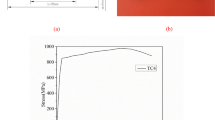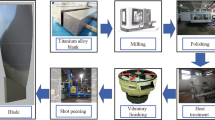Abstract
Fan blade is an important component of turbofan engine. It is a kind of curved thin-walled structural parts, which tends to have a certain amount of deformation after machining process. In order to predict the deformation of fan blade after machining process, the commercial simulation software Abaqus® is used to analyze the deformation of fan blade with titanium alloy through considering the effect of residual stress. The residual stresses on the surface and subsurface of the blade after milling and shot peening processes were measured and analyzed by experimental testing. Based on the measured residual stress data, the three-dimensional model of fan blade is segmented by the operation of extracting geometric features. Then, the residual stress values are discretized according to separation layers, and the discrete results are applied to the thin-walled blade by dividing layers and dividing regions. Finally, a finite element analysis (FEA) model for the deformation prediction of blade through considering the effect of residual stress is established. The simulation deformation is compared with the measured deformation, and the feasibility of the FEA model is verified. The study provides an effective analysis method for the deformation prediction of fan blade after milling and shot peening processes.














Similar content being viewed by others
References
Pu X, Zhang C, Li S, Deng D (2017) Simulating welding residual stress and deformation in a multi-pass butt-welded joint considering balance between computing time and prediction accuracy. Int J Adv Manuf Technol 93(5–8):2215–2226
Cui M-C, Zhao S-D, Zhang D-W, Chen C, Li Y-Y (2017) Finite element analysis on axial-pushed incremental warm rolling process of spline shaft with 42CrMo steel and relevant improvement. Int J Adv Manuf Technol 90(9–12):2477–2490
Cui M-C, Zhao S-D, Zhang D-W, Chen C, Fan S-Q, Li Y-Y (2017) Deformation mechanism and performance improvement of spline shaft with 42CrMo steel by axial-infeed incremental rolling process. Int J Adv Manuf Technol 88(9–12):2621–2630
Lu LX, Sun J, Li YL, Li JF (2017) A theoretical model for load prediction in rolling correction process of thin-walled aeronautic parts. Int J Adv Manuf Technol 92(9–12):4121–4131
Cao Y, Bai Y, He Y, Tian J, Li Y (2014) NC milling deformation forecasting of aluminum alloy thin-walled workpiece based on orthogonal cutting experiments and CAD/CAM/FEA integration paper title. IJCA 7(9):67–80
Wang L-y, H-h H, West RW, H-j L, J-t D (2018) A model of deformation of thin-wall surface parts during milling machining process. J Cent South Univ 25(5):1107–1115
Wang L, Si H (2018) Machining deformation prediction of thin-walled workpieces in five-axis flank milling. Int J Adv Manuf Technol 97(9–12):4179–4193
P-f L, Liu Y, Y-d G, L-l L, Liu K, Sun Y (2018) New deformation prediction of micro thin-walled structures by iterative FEM. Int J Adv Manuf Technol 95(5–8):2027–2040
Si-meng L, Xiao-dong S, Xiao-bo G, Dou W (2017) Simulation of the deformation caused by the machining cutting force on thin-walled deep cavity parts. Int J Adv Manuf Technol 92(9–12):3503–3517
Chen TT, Rong B, Yang YF, Zhao W, Li L, He N (2014) FEM-based prediction and control of milling deformation for a thin-wall web of Ti-6Al-4V alloy. MSF 800-801:368–373
Fei J, Lin B, Yan S, Ding M, Zhang X, Zhang J, Lan J (2018) Theoretical prediction and experimental validation of dynamic deformation during machining of thin-walled structure. In: proceedings of the ASME International Mechanical Engineering Congress and Exposition − 2017: presented at ASME 2017 International Mechanical Engineering Congress and Exposition, November 3–9, 2017, Tampa, Florida, USA. The American Society of Mechanical Engineers, New York, NY, V002T02A004
Huang X, Sun J, Li J (2015) Finite element simulation and experimental investigation on the residual stress-related monolithic component deformation. Int J Adv Manuf Technol 77(5–8):1035–1041
Cheng Y, Zuo D, Wu M, Feng X, Zhang Y (2015) Study on simulation of machining deformation and experiments for thin-walled parts of titanium alloy. IJCA 8(1):401–410
Ouyang HB (2014) Deformation prediction based on BP artificial neural network of milling thin-walled aluminum alloy parts. AMM 687-691:492–495
Wang MT, Zeng YS, Bai XP, Huang X (2014) Deformation rule of 7150 aluminum alloy thick plate by pre-stress shot peen forming. AMR 1052:477–481
Achintha M, d. Nowell, Shapiro K, Withers PJ (2013) Eigenstrain modelling of residual stress generated by arrays of laser shock peening shots and determination of the complete stress field using limited strain measurements. Surf Coat Technol 216: 68–77
Gallitelli D, Boyer V, Gelineau M, Colaitis Y, Rouhaud E, Retraint D, Kubler R, Desvignes M, Barrallier L (2016) Simulation of shot peening: from process parameters to residual stress fields in a structure. Comptes Rendus Mécanique 344(4–5):355–374
Salvati E, Lunt AJG, Ying S, Sui T, Zhang HJ, Heason C, Baxter G, Korsunsky AM (2017) Eigenstrain reconstruction of residual strains in an additively manufactured and shot peened nickel superalloy compressor blade. Comput Methods Appl Mech Eng 320:335–351
Huai W, Shi Y, Tang H, Lin X (2019) An adaptive flexible polishing path programming method of the blisk blade using elastic grinding tools. J Mech Sci Technol 33(7):3487–3495
Yao C, Tan L, Yang P, Zhang D (2018) Effects of tool orientation and surface curvature on surface integrity in ball end milling of TC17. Int J Adv Manuf Technol 94(5–8):1699–1710
Wu D, Yao C, Zhang D (2018) Surface characterization and fatigue evaluation in GH4169 superalloy: comparing results after finish turning; shot peening and surface polishing treatments. Int J Fatigue 113:222–235
Yao C, Wu D, Ma L, Tan L, Zhou Z, Zhang J (2016) Surface integrity evolution and fatigue evaluation after milling mode, shot-peening and polishing mode for TB6 titanium alloy. Appl Surf Sci 387:1257–1264
Liu C, Goel S, Llavori I, Stolf P, Giusca CL, Zabala A, Kohlscheen J, Paiva JM, Endrino JL, Veldhuis SC, Rabinovich F, German S (2019) Benchmarking of several material constitutive models for tribology, wear, and other mechanical deformation simulations of Ti6Al4V. J Mech Behav Biomed Mater 97:126–137
Funding
This work was funded by the National Natural Science Foundation of China (Grant Nos. 51875472, 51905440, and 91860206), the National Science and Technology Major Project (Grant No. 2017-VII-0001-0094) and the National Key Research and Development Plan in Shaanxi Province of China (Grant No. 2019ZDLGY02-03).
Author information
Authors and Affiliations
Corresponding author
Additional information
Publisher’s note
Springer Nature remains neutral with regard to jurisdictional claims in published maps and institutional affiliations.
Rights and permissions
About this article
Cite this article
Yao, C., Zhang, J., Cui, M. et al. Machining deformation prediction of large fan blades based on loading uneven residual stress. Int J Adv Manuf Technol 107, 4345–4356 (2020). https://doi.org/10.1007/s00170-020-05316-8
Received:
Accepted:
Published:
Issue Date:
DOI: https://doi.org/10.1007/s00170-020-05316-8




